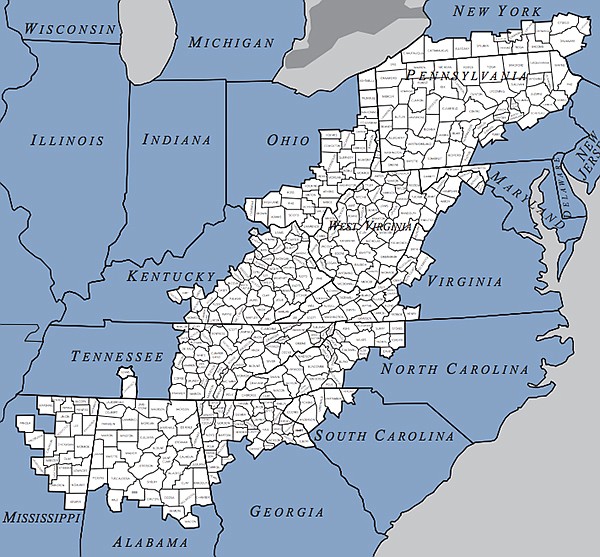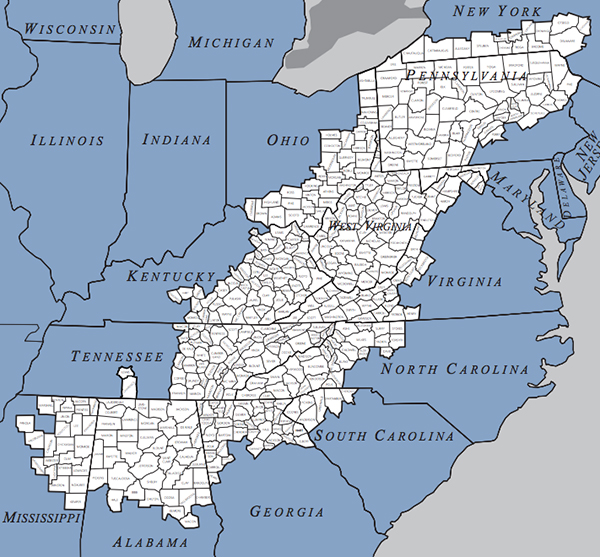Appalachia includes a broad swath of territory extending from southern New York, Pennsylvania and Ohio southward to involve all of West Virginia, parts of Virginia, Maryland, North and South Carolina, Eastern Kentucky and Tennessee and northern portions of Georgia, Alabama and Mississippi (see map at Appalachian Regional Commission, www.arc.gov/appalachian_region/MapofAppalachia.asp). The name comes from the Appalachian Mountains, which form a geological backbone for the region.
Appalachia encompasses 420 counties with more than 25 million residents. Ninety-three counties are currently considered economically distressed. Many of the depressed counties are in Eastern Kentucky. Nine are in Tennessee.
Health within Appalachia, particularly its midsection, is slipping compared to the rest of the U.S. A review in the August issue of Health Affairs analyzes this discrepancy in terms of infant mortality and life expectancy from 1990 to 2013. The gaps in these measures increased during this interval.
From 1992 to 1994, infant mortality in Appalachia, 9.2 per 1,000 live births, was close to the rest of the country, 9.3 per 1,000 live births. From 2009 to 2013, infant mortality showed a 16 percent increase relative to the areas outside Appalachia. Income is a determining factor in infant mortality. Appalachian infant mortality is 39 percent higher than low-poverty regions of the country.
Life expectancy shows striking disparities. Appalachian residents died 0.6 years earlier than people outside the region in the interval 1990-1992. By 2009-2013, the gap had increased to 2.6 years. The starkest gap in life expectancy - 13 years - was seen between African-American males in high-poverty areas of Appalachia compared with white females in low-poverty regions in the rest of the nation.
Cardiovascular disease, cancer and unintentional injuries - which include drug overdoses - accounted for almost 60 percent of the gap. Lung cancer was prominent among malignancies. Chronic obstructive pulmonary disease, diabetes, chronic kidney disease and suicide occurred more frequently in Appalachia.
Diseases related to tobacco-smoking accounted for more than half of the life-expectancy gap. West Virginia, Kentucky and Arkansas have the highest incidence of smoking in the U.S. A band of states extending from Michigan southward to the Gulf of Mexico includes states with a higher incidence of smoking than the rest of the country.
Within Appalachia, cities and urban counties may prosper while surrounding counties are economically left behind. Mining and logging, which were major employers, have steadily declined. Worsening prospects for employment have led to a steady exodus of young people from the region.
In many respects, central Appalachia is America's Third World - a belt of economic and social despair.
Harry Caudill's "Night Comes to the Cumberlands: A Biography of a Depressed Area," published in 1962, traces the history of the coal-mining region of central Appalachia, encompassing Eastern Kentucky and West Virginia, from its earliest settlement to 1960. After the Civil War, the region became a progressively isolated, energy colony within a steadily more prosperous nation. Once-fertile valleys were rendered barren by runoff from mining operations. Little of the wealth generated by coal mining filtered to the miners and their families and communities. The book is credited with raising national awareness of the plight of people in Appalachia.
John F. Kennedy won a crucial primary victory in West Virginia in 1960 in his campaign for the Democratic Party nomination for president. Subsequently, the Kennedy Foundation supported projects for economic betterment in the state.
Both Presidents Kennedy and Johnson had strong, bipartisan support in addressing poverty in Appalachia. One notable outcome is the Appalachian Regional Commission. Established in 1965, the commission combines federal and state resources to support a broad range of programs to improve health, education, economic development and community infrastructure. Initiatives developed by the commission have progressively shrunk the area of economic and social distress, but it has taken 50-plus years to do so.
The report in Health Affairs indicates that there is still much work to be done on behalf of the Americans who live in Appalachia.
Contact Clif Cleaveland at ccleaveland@timesfreepress.com.


